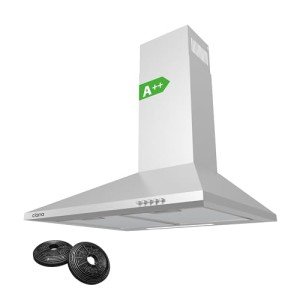
Stove Extractor Fan
Add a review FollowOverview
-
Founded Date May 21, 2004
-
Sectors Education & Training
-
Posted Jobs 0
-
Viewed 2
Company Description
5 Killer Quora Answers On Cooker Hood Extractor
The Essential Guide to Cooker Hood Extractors: A Homeowner’s Companion
When designing a kitchen, one vital element typically neglected is the cooker hood extractor. This home appliance is not just a practical need; it can elevate your kitchen’s design while considerably improving air quality. This post will look into the value of cooker hood extractors, check out various types readily available, and discuss their benefits, setup, and upkeep.
What is a Cooker Hood Extractor?
A cooker hood extractor, frequently described simply as a hood or extractor, is a kitchen appliance installed above the stovetop. Its main function is to get rid of air-borne grease, smoke, steam, and smells created throughout cooking. By successfully venting these toxins outside or filtering them for recirculation, a cooker hood preserves a clean cooking environment.
The Importance of a Cooker Hood Extractor
Improved Air Quality
Cooking produces different pollutants that can result in bad indoor air quality. A cooker hood extractor removes these contaminants, avoiding them from distributing throughout the home. Good air quality is essential for breathing health and general wellness.
Boosted Kitchen Comfort
Cooking can produce heat and humidity that makes the kitchen unpleasant. An effective hood extractor helps dissipate heat and moisture, developing a more pleasant cooking environment.
Protection for Interior Surfaces
Grease and smoke can pick kitchen surface areas, leading to filthy and sticky counter tops, cabinets, and walls. A cooker hood extractor helps in reducing these deposits, prolonging the life of your kitchen surfaces.
Aesthetic Enhancement
Modern cooker hood extractors come in different designs, making them a stylish addition to any kitchen. From smooth stainless steel to custom kitchen cabinetry designs, the right hood can improve your kitchen’s total aesthetic.
Prospective Increased Home Value
A well-chosen cooker hood extractor can increase the value of your home by enhancing both performance and design. Homebuyers typically search for kitchens equipped with modern appliances, which can lead to a quicker sale and possibly a higher cost.
Types of Cooker Hood Extractors
When choosing a cooker hood extractor, homeowners can choose from various types based on their kitchen style and cooking habits. Below is a comprehensive list outlining these types:
| Type | Description | Pros | Cons |
|---|---|---|---|
| Wall-Mounted | Set up on the wall above the stove. | Space-saving, ideal for small kitchens. | Needs wall space, limited height. |
| Under-Cabinet | Mounted beneath kitchen cabinets. | Discreet, easy setup. | May reduce cabinet space. |
| Island Hoods | Hung from the ceiling above an island cooktop. | Statement piece, perfect for open designs. | Needs ceiling height and support. |
| Downdraft | Withdraws when not in usage, set up within the counter top. | Streamlined design, unobtrusive. | Less reliable for bigger ranges. |
| Chimney Hoods | Functions a chimney that vents to the outside. | High efficiency, suitable for heavy cooking. | Needs substantial installation work. |
Picking the Right Cooker Hood Extractor
When picking the right cooker hood extractor, numerous factors ought to be considered:
-
Size and Compatibility: Ensure the size of the hood matches your cooktop. It must be at least as wide as the cooking surface for optimum performance.
-
Extraction Power: This is determined in cubic meters per hour (m ³/ h). A greater extraction rate is essential for bigger cooking locations or heavy cooking styles.
-
Kind of Ventilation: Decide in between ducted (venting air exterior) and recirculating (filtering air and returning it) hoods based upon your kitchen layout.
-
Sound Level: Most hoods produce noise, measured in decibels (dB). Pick a model with a low dB score for quieter operation.
-
Style and Style: The hood needs to match your kitchen’s aesthetic. Think about surfaces and designs that match your general style.
Setup and Maintenance
Setup
Proper setup is crucial for the efficiency of the cooker hood extractor. It is generally suggested to work with a professional who can guarantee it is installed securely and vented properly. The height from the cooking surface need to typically be:
- 65-75 cm for electrical cooktops
- 75-85 cm for gas cooktops
Maintenance
Regular upkeep makes sure the durability and effectiveness of the cooker hood. Here are some essential suggestions:
-
Clean Filters Regularly: Metal filters ought to be washed each month. Grease filters might require more frequent cleaning depending on use.
-
Inspect Ventilation Ducts: Inspect ducts every six months for grease buildup. Tidy as required to make sure smooth air flow.
-
Wipe Down the Surface: Stainless steel and other surfaces need to be cleaned down routinely to maintain look and prevent residue accumulation.
-
Change Filters: Charcoal filters ought to be changed every 6-12 months if you have a recirculating model.
FAQs About Cooker Hood Extractors
Q1: Is a cooker hood extractor necessary for each kitchen?
Yes, a cooker hood extractor is extremely suggested for every kitchen, particularly if you take pleasure in cooking regularly. It improves air quality, comfort, and cleanliness.
Q2: How do I understand what size cooker hood to purchase?
Select a cooker hood that is at least as broad as your cooktop. The perfect height has to do with 65-85 cm above the cooking surface.
Q3: Are ducted hoods better than recirculating hoods?
Ducted hoods are usually more effective and reliable at eliminating cooking smells and wetness, as they vent air outside. Recirculating hoods can be suitable for homes where ducting is not possible.
Q4: Can I set up a cooker hood myself?
While some house owners may attempt DIY setup, it is suggested to employ a professional to guarantee appropriate setup and venting, especially for ducted designs.
Q5: How often should I clean my cooker hood extractor?
Metal filters should be cleaned monthly, while charcoal filters require to be changed every 6-12 months, depending on usage.
A cooker hood extractor is a vital part of any modern kitchen. From boosting air quality to enhancing aesthetic appeal, its advantages are manifold. By picking the right type, making sure proper setup, and devoting to routine maintenance, homeowners can take pleasure in a cleaner, healthier, and more satisfying cooking environment for many years to come. Whether cooking everyday meals or preparing for unique celebrations, the right cooker hood extractor makes all the distinction.

